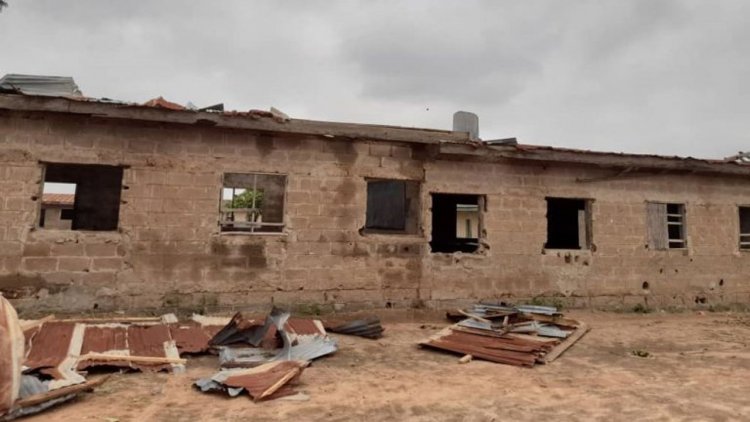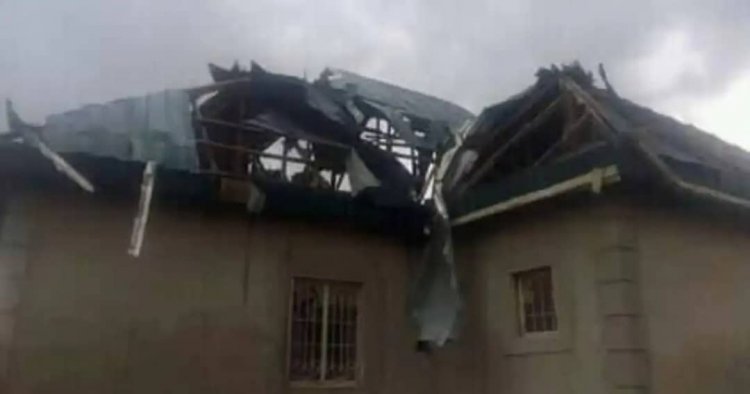Impacts of Rainstorms on Residential Buildings in Nigeria

The rate at which rainstorms sabotage and extirpate buildings is increasing day by day and is quite alarming and staggering. Rainstorms have been a bane and blip to residential buildings in Nigeria and the world entirely. It has been tampering with the existence of buildings and has been a nocuous occurrence. The negative impact of rainstorms can never be overemphasized or underestimated while discussing buildings in Nigeria generally.
Rainstorm causes a multitude of different damage scenarios in the present situation. It's a devastating occurrence to the building.
Rainstorms can simply be described as the deluge or the barrage of rains characterized by storms. Rainstorms can be said to distort and deform the foundation and shape of a building.
Research has shown that the impacts of rainstorms on buildings in urban areas are often extensive. Usually, the negatives consequences of that environmental risk compared to storms or hail events are usually underrated. Moreover, the intensification of excessive weather events due to the change in climate including the rising physical susceptibility of assets are going to engender an increase of impacts on the built environment.
Rainstorms are highly localized, which makes it difficult to assess their probability and gravity circumspectly as the most thorough rain may not have been sampled reliably by the available rain gauges. High-intensity rain and rainstorms affect buildings directly and indirectly.
In recent times, engineering surveys have proven the variety and high physical susceptibility of building constructions which are constantly affected by invading water during heavy rains which cause rainstorms and which are; flat roofs, roof terraces, and balconies, soil-covered slabs of underground parking, the connections between steep roofs and other building parts, soil-contacted basement walls and bottom plates including windows and external doors.
It is pertinent that most damages are evitable if the exposed constructions become more flexible. Any adaptations require expertise on the demanding damage processes in order to examine the inadequacies and to lessen the physical susceptibility of building constructions exposed to heavy rainstorms.
A rainstorm may result in urban pluvial flooding due to sewer overflow that causes damage to buildings. A comprehensive study of the impacts and the consequences in the city of Dresden (Germany) disclosed that the noumenon risks of flooding from sewers due to hydraulic overload can be estimated on building scale using the model approach IVART (Integrated Spatial Vulnerability and Risk Assessment Tool).
Commonwealth of nations' results provides the basis to estimate the effectiveness and efficiency of flood resilience technologies.
Global climate change is measurable and the projections of its prospective regional impacts are crucially critical for modification planning. It is pertinent that the probability and gravity of perilous rainstorms have been increasing in European regions within the last 40 years (Grieser and Beck 2002).
The negative impact of a rainstorm virtually depends on the physical susceptibility of buildings, i.e. on the noumenon of exposed materials and structures (e.g. roofs, façade) to be detrimental and to be damaged.
The impacts of rainstorms are challenging the adaptation of existing buildings, the prerequisites to develop adequate adaptation measure is to explore the impact in detail.
Typical damage profiles caused by heavy rainstorms include moisture penetration, water stains, and efflorescence on inner building elements, as well as water influx through the building shell. These are often accompanied by damages to the fabric of the buildings.

Precautions Against Rainstorms
The following measures can be put in place to avoid rainstorms in Nigeria.
Gutter and Downspouts.
It is significant and crucial to have a well-running gutter system to avoid rain getting inside the building or damaging the building's foundation. The gutters must be clean to avoid clogging and water overflow. There are various products that can be used in maintaining the gutters and make them free of debris.
The gutters are seen as the middleman from the roof to the ground, keeping rainwater from running down the building’s walls. It can be directed to the downspouts away from the foundation of the building and guide the water to a garden or vegetation. Clean gutters and proper use of downspouts will definitely keep the building’s foundation intact no matter the level of rainstorms.
Roof Inspection
The roof is obviously the first line of defense against most weather conditions, especially rainstorms. The roof must be adequately monitored and inspected for loose shingles, soft spots, and surface divots. One crack in the roof can lead to a roof leak and then further internal damage to the walls and ceilings.
Solid Foundation
A solid foundation is a key to keep rainwater runoff away from buildings' foundations. The ground in which the building is surrounded should be sloping downward away from the foundation. It is advisable to have at least five feet of a downward slope to achieve the maximum benefit of avoiding runoff damage. When the rainwater puddles around the buildings, the water seeps into the ground and can crack the foundation. Once cracks form, water can leak in, making the basement damp or wet. The dampness in the basement will attract mold and mildew, along with termites and carpenter ants. These setbacks can be prevented by properly keeping water away from the building.
Rainwater collecting system
The installation of a rainwater catchment system is another option for handling rainstorms. The rainwater flows from the gutter, travels through the downspout, and into the tank or barrel. The rainwater can be remodeled for irrigation or seasonal purposes. Rainwater collectors vary depending on what you need them for.
Water damages are one of the most costly damages to the building. If not treated immediately, it will have serious long-term damages that might need serious repairs, if not replaced altogether.
It highly advised to stay prepared and prevent water damage before it is too late.

 Adedokun Boluwatife
Adedokun Boluwatife 































